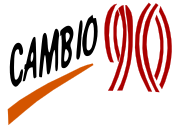Cambio 90
Change 90 (Spanish: Cambio 90), was a Right-wing Peruvian political party which entered the political spectrum in early 1990, and by June 1991 was the most powerful political force in the nation. Cambio 90 was the ruling party of Peru from 1990 to 2000.
Change 90 Cambio 90 | |
|---|---|
 | |
| Secretary | Renzo Reggiardo |
| Founder | Alberto Fujimori |
| Founded | 1989 |
| Dissolved | 2013[1] |
| Succeeded by | Perú Patria Segura |
| Ideology | Fujimorism (historical) National conservatism Social conservatism Economic liberalism Right-wing populism Christian Humanism |
| Political position | Right-wing |
| National affiliation | Peru 2000 (1999-2005), Alliance for the Future (2005-2010) |
| International affiliation | None |
History
Cambio's success hinged largely on the success of its candidate for the presidency, Alberto Fujimori, an agricultural engineer and rector of the Universidad Nacional Agraria (National Agrarian University) in Lima's La Molina District from 1984 to 1989. Fujimori's appeal to a large extent was his standing as a political outsider.
At the same time, Cambio's success was also attributed largely to its eclectic political base and its active grassroots campaign. Its two main bases of support were the Asociación Peruana de Empresas Medias y Pequeñas (APEMIPE), an association of SMEs, and the informal sector workers who associated their cause with APEMIPE, and the Evangelical movement. Less than four percent of the Peruvian population was Protestant, but the evangelicals were extremely active at the grassroots level, particularly in areas where traditional parties were weak, such as the urban shantytowns, the pueblos jóvenes, and rural areas in the mountains. Although the party only began activities in January 1990, by the time of the elections it had 200,000 members in its ranks.
However, its success at the polls did not translate into a lasting party machinery. The organization was much more of a front than a political party, and its ability to hold together was called into question within a few weeks after attaining power. Cambio's two bases of support had little in common with each other except opposition to Mario Vargas Llosa. Its links to Fujimori were new and were ruptured to a large extent when Fujimori opted for an orthodox economic shock program. Less than six months into his government, Fujimori broke with many of his Cambio supporters, including the second vice president and leader of the evangelical movement, Carlos García y García, and APEMIPE. The latter became disenchanted with Fujimori because small businesses were threatened by the dramatic price rises and opening to foreign competition that the Fujishock program entailed.
In the 8 April 2001 legislative elections, the party won 4.8% of the popular vote and 3 out of 120 seats in the Congress of the Republic.
Electoral history
Presidential elections
| Election date | Party candidate | Number of votes | Percentage of votes | Number of votes | Percentage of votes | Result |
|---|---|---|---|---|---|---|
| First Round | Second Round | |||||
| 1990 | Alberto Fujimori | 1,932,208 | 29.1% | 4,478,897 | 62.4% | Elected |
| 1995 | Alberto Fujimori | 4,645,279 | 64.3% | Elected | ||
| 2000 | Alberto Fujimori (as part of Peru 2000) | 5,528,568 | 49.9% | 6,041,685 | 74.3% | Elected |
| 2006 | Martha Chávez Cossio
(as part of Alliance for the Future) |
912,420 | 7.4% | Lost | ||
| 2011 | Luis Castañeda Lossio (as part of National Solidarity Alliance) | 1,440,143 | 9.8% | Lost | ||
Congressional elections
| Election date | Number of votes | Percentage of votes | Number of seats |
|---|---|---|---|
| 1990 | 819,527 | 16.5% | 32 / 180 |
| 1995 | 2,193,724 | 51.1% | 67 / 120 |
| 2000 | 4,189,018 (as part of Peru 2000) | 42.2% | 52 / 120 |
| 2001 | 452,696 | 4.8% | 3 / 120 |
| 2006 | 1,408,055 (as part of Alliance for the Future) | 13.1% | 13 / 120 |
| 2011 | 1,311,766 (as part of National Solidarity Alliance) | 10.2% | 9 / 130 |
Senate elections
| Election date | Number of votes | Percentage of votes | Number of seats |
|---|---|---|---|
| 1990 | 1,240,132 | 21.7 | 14 / 62 |
See also
References
- "Renzo Reggiardo cambia de nombre a Cambio 90 y lanza nuevo partido". Perú 21 (in Spanish). December 28, 2013. Archived from the original on February 2, 2014. Retrieved November 5, 2014.